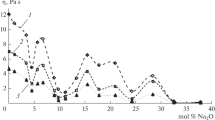Abstract
High-temperature melts are substances which are solids at room temperature and liquids at high temperatures. They include liquid metals, molten salts, and other melts such as molten semiconductor materials. Although they show scientifically interesting behavior and have industrially important characteristics, the thermophysical properties of these substances at high temperature are not sufficiently known due to experimental difficulties. Many melts show strong chemical activity and therefore are corrosive to materials of container and sensors. Applicable sensors are limited also because of the high temperature and the electrical conductivity of melts. In this paper the present status of available data for the viscosity, the thermal conductivity, and the surface tension of high-temperature melts is reviewed. Limited experimental information is available and these properties are difficult to predict theoretically. The transport properties are important for predicting heat transfer and flow patterns. For the prediction of the behavior of melts under microgravity condition, the temperature dependence of the surface tension plays a major role.
Similar content being viewed by others
References
A. Nagashima,Appl. Mech. Rev. 41:113 (1988).
Properties of Electroslag, A report (The Iron and Steel Institute of Japan, 1979) (in Japanese).
Survey of References on Physico-Chemical Properties of Molten Metals, Alloys, Slags and Molten Salts, A report of Committee 140 of the Japan Society for Promotion of Sciences (1982).
K. Furukawa and H. Ohno,Data Books for Molten Materials. I. Molten LiF-BeF 2 System (Japan Nuclear Energy Information Center, 1980).
Data Books for Molten Materials. II. HTS (Japan Nuclear Energy Information Center, 1988).
G. J. Janz,Proc. 4th Jap. Symp. Thermophys. Prop., Yokohama, (1983), p. 199; G. J. Janz,High. Temp. Sci. 19:173 (1985). Other references are listed also in Ref. 1.
T. Ito, K. Minami, and A. Nagashima, Paper presented at 10th Symp. Thermophys. Prop., Gaithersburg, Md. (1988).
R. W. Ohse (ed.),Handbook of Thermodynamic and Transport Properties of Alkali Metals (Blackwell, Oxford, 1985).
K. Kamimoto and T. Hibiya,Appl. Phys. Lett. 50:1249 (1987).
V. M. Glazov, S. N. Chizhevskaya, and N. N. Glagoleva,Liquid Semiconductors (Plenum, New York, 1988), 68.
S. Ozawa, M. Eguchi, T. Fujii, and T. Fukuda,Appl. Phys. Lett. 51:197 (1987).
Y. Nagasaka and A. Nagashima, Paper presented at 10th Symp. Thermophys. Prop., Gaithersburg, Md. (1988).
V. I. Fedorov and V. I. Machuev,Teplofiz. Vys. Temp. 8:912 (1970).
P. V. Polyakov and E. M. Gildebrandt,Teplofiz. Vys. Temp. 12:892 (1974).
G. P. Bystrai, V. N. Desyatnik, and V. A. Zlokazov,Atom. Energ. 36:517 (1974).
J. McDonald and H. T. Davis,Phys. Chem. Liq. 2:119 (1971).
Y. Nagasaka and A. Nagashima,Int. J. Thermophys. (in press).
H. Bloom, A. Doroszkowski, and S. B. Tricklebank,Aust. J. Chem. 18:1171 (1965).
J. McDonald and H. T. Davis,J. Phys. Chem. 74:725 (1970).
T. Omotani, Y. Nagasaka, and A. Nagashima,Int. J. Thermophys. 3:17 (1982).
T. Omotani and A. Nagashima,J. Chem. Eng. Data 29:1 (1984).
A. R. Regel, I. A. Smirnov, and E. V. Shadrichev,Phys. Stat. Sol. (a)5:13 (1971).
B. Sundqvist and G. Backstrom,Rev. Sci. Instrum. 47:177 (1976).
V. M. Glazov, S. N. Chizhevskaya, and N. N. Glagoleva,Liquid Semiconductors (Plenum, New York, 1988), p. 25.
M. Takeuchi et al.,Proc. 1983 ASME-JSME Therm. Eng. Joint Conf., Hawaii, Vol. 3 (1983), p. 341.
L. A. Pirog,Izv. Vyssh. Uchebn. Zaved. Tsvetn. Metall. 6:109 (1986).
A. Passerone, R. Sangiorgi, and G. Caracciolo,J. Chem. Thermodyn. 15:971 (1983).
L. Goumiri and J. C. Joud,Acta Metall 30:1397 (1982).
S. C. Hardy,J. Crystal Growth 69:456 (1984).
M. Murase, H. Matsubara, Y. H. Mori, and A. Nagashima,Trans. JSME 51B:2638 (1985).
B. J. Keene,Surf. Interface Anal. 10:367 (1987).
T. P. Kolesnikova,Izv. VUZ Chern. Metal. 9:14 (1960).
B. C. Allen,Handbook of Thermodynamic and Transport Properties of Alkali Metals, R. W. Ohse, ed. (Blackwell, Oxford, 1985), pp. 691–700.
T. Iida and R. L. Guthrie,The Physical Properties of Liquid Metals (Oxford, 1988), pp. 109–146.
Author information
Authors and Affiliations
Rights and permissions
About this article
Cite this article
Nagashima, A. Viscosity, thermal conductivity, and surface tension of high-temperature melts. Int J Thermophys 11, 417–432 (1990). https://doi.org/10.1007/BF01133571
Issue Date:
DOI: https://doi.org/10.1007/BF01133571




